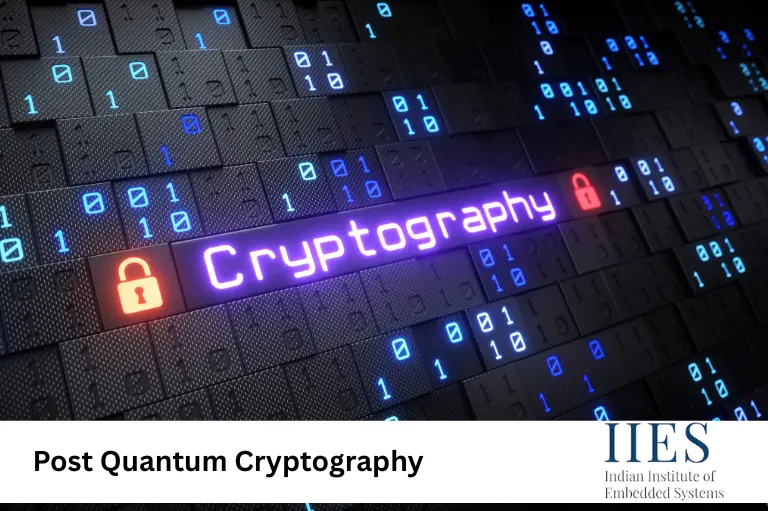
Post Quantum Cryptography (PQC) is a revolutionary branch of cryptography focused on developing algorithms that can resist attacks from quantum computers. As quantum computing progresses, traditional encryption methods like RSA and ECC become increasingly vulnerable. PQC ensures data security for the next generation of digital communication systems by providing quantum-safe encryption solutions essential for IoT, embedded systems, and critical infrastructure.
Post Quantum Cryptography introduces quantum-resistant algorithms designed to protect data from future quantum-based threats. Just as quantum cryptography advanced secure communication, PQC focuses on making today’s encryption methods resilient against tomorrow’s quantum attacks. Understanding PQC is vital for professionals in cybersecurity, IoT, and embedded domains to build systems that remain secure in a post-quantum world.
Post Quantum Cryptography (PQC) is a new generation of cryptographic algorithms designed to resist attacks from quantum computers. These algorithms ensure quantum secure communication by replacing traditional methods that are vulnerable to Shor’s and Grover’s algorithms.
Traditional public key systems such as:
RSA (Rivest Shamir Adleman)
Elliptic Curve Cryptography (ECC)
Diffie Hellman Key Exchange
are effective against today’s threats but can be easily broken by quantum computation in the future.
That is why the transition to quantum safe encryption is no longer optional. It is an essential step to protect sensitive data from the “harvest now, decrypt later” threat, where attackers collect encrypted data today and decrypt it once quantum computing power becomes available.
| Property | Traditional Encryption (RSA/ECC) | Post Quantum Cryptography (PQC) |
| Resistance | Vulnerable to Quantum Attacks | Quantum Resistant Algorithms |
| Usage | Secure Boot, Firmware Updates, Authentication | IoT Device Security, Quantum Safe Encryption |
| Speed | Faster | Moderate (depends on algorithm) |
| Hardware Needs | Low | Requires optimization for IoT Hardware |
| Agility | Limited | Supports Crypto Agility |
| Standardization | Existing protocols (TLS 1.2/1.3) | Post Quantum TLS under NIST PQC Standards |
Quantum computers use qubits and superposition to perform complex calculations exponentially faster than classical systems. This means RSA keys can be factored in seconds, ECC curves can be broken using Shor’s algorithm, and encrypted data stored today could be vulnerable tomorrow. That is why industries dealing with IoT security, firmware updates, and authentication must act proactively.
RSA relies on the difficulty of factoring large prime numbers. A quantum computer running Shor’s algorithm can solve this in polynomial time, making it possible to extract private keys.
// Simplified example: classical RSA encryption
int encrypt(int data, int key) {
return (data ^ key); // symbolic example only
}
While this code seems secure today, quantum cryptography research shows it is only a matter of time before such schemes become obsolete.
Quantum Safe Encryption uses lattice-based, hash-based, or multivariate algorithms that are resistant to quantum attacks. These quantum-resistant algorithms form the foundation of Post Quantum TLS (Transport Layer Security) to ensure encrypted communication between IoT devices and cloud servers remains protected.
IoT devices, often built with minimal processing power and long life cycles, face unique challenges in adopting PQC. Here is a practical roadmap to make IoT systems quantum secure.
While Post Quantum Cryptography strengthens long-term security, it introduces practical trade-offs. Larger key sizes demand more firmware memory, performance may be slower on low-power hardware, and algorithms must be optimized for embedded devices. For example, smart meters or industrial sensors designed for long lifespans may require hybrid updates rather than immediate replacement.
| Feature | Traditional Crypto | Post Quantum Cryptography |
| Resistance | Weak against Quantum | Quantum Resistant |
| Performance | Fast | Slightly Slower |
| IoT Compatibility | High | Requires Optimization |
| Agility | Low | High (Crypto Agile) |
| Key Algorithms | RSA, ECC | Kyber, Dilithium, SPHINCS+ |
| Security Standard | TLS 1.3 | Post Quantum TLS (NIST PQC Standards) |
Post Quantum Cryptography for IoT is not only about future proofing but ensuring secure and trustworthy communication across connected devices. With the rise of quantum computing, embracing quantum-safe encryption, crypto agility, and hybrid algorithms is the only sustainable path forward. By aligning with NIST PQC standards, updating firmware and hardware agility, and participating in pilot implementations, you can protect your IoT ecosystem from tomorrow’s most advanced threats starting today.
It is a set of encryption algorithms designed to remain secure against attacks from quantum computers.
IoT devices have long lifespans and limited hardware, so they require quantum-resistant algorithms to maintain security over time.
A hybrid encryption method that combines traditional TLS with PQC algorithms, such as Kyber, for quantum-secure communication.
They are the U.S. government’s standardized set of quantum-safe encryption algorithms, such as Kyber and Dilithium.
By implementing crypto agility, updating firmware, and using PQC-ready hardware for future-proof security.
Indian Institute of Embedded Systems – IIES